Introduction
External Environment Analysis of JCPenny will be analysed in this report. It is found in research that strategic management refers to conducting business strategies in order to accomplish the business purposes and aims of companies. JCPenny is an American fashion brand that has 846 outlets across the US (Forbes, 2020). The company has been facing a loss of about $4.5 billion for the last ten years and has failed to overcome the struggle to make its position stronger in the UK market (Forbes, 2020). In this report, a company analysis of JCPenny will be conducted in order to identify the mistakes that the company has made, and some recommendations will be provided to improve its position in the US market.
You may feel interested to read below blogs:
Effectiveness of the Business Strategies of Crowne Plaza Hotel
Internal External and Competitive Environment of Domino’s Pizza
Business strategies of Bang & Olufsen
Resort Management Strategies of One&Only
Effectiveness of Pret A Manger’s Business Strategies
Porter’s Generic Strategies of JCPenny:
González‐Benito & Suárez‐González (2010) have revealed in their research that Porter’s generic strategies refer to the set of strategies which are used to make an organization’s services and products different from its competitors to get more customers. By utilizing the strategies of Porter’s generic model, companies enhance their competitive position. JCPenny will be capable of enhancing its competitive advantage by adopting strategies from the model.
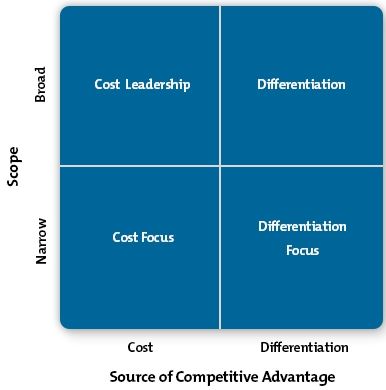
Cost leadership, differentiation, focus and differentiation focus are the strategies of Porter’s five forces model that companies can adopt. Firstly, cost leadership refers to the strategy that encourages companies to focus on reducing their operational and other costs to reduce the price of their services and become the lower cost service providers of the market (Nandakumar, Ghobadian & O’Regan, 2011). Secondly, Differentiation is the strategy that encourages companies to make their products and services different from their competitors to fulfil the core demand of customers and create an exceptional image in their minds (Tansey, Spillane & Meng, 2014). Thirdly, Cost focus indicates the process that encourages companies to fulfil customers’ unfulfilled demand at a lower prices (Tanwar, 2013). Whilst, differentiation focus is fulfilling customers’ unfulfilled demand within the premium price (Tanwar, 2013). The disadvantage of the model is companies have to adopt two strategies together for the reason that one strategy of the model does not work properly most of the time.
Among all the strategies of Porter’s generic model, JCPenny conducts a differentiation focus strategy to enhance its competitive advantage within the targeted market. It targets middle-aged women over 45 years of US with the brands such as Liz Claiborne without targeting customers of other ages (Forbes, 2020). JCPenny has taken this strategy to clear their inventory of the brands which are out of the fashion trend of the US in recent days.
Ansoff’s growth matrix of JCPenny:
Taylor (2012) has found in his research that Ansoff’s matrix is the set of strategies that assists companies in increasing their sales and ensure growth by conducting the appropriate strategies from the model. Companies should adopt compatible strategies from the model by considering their financial resources and internal capabilities.
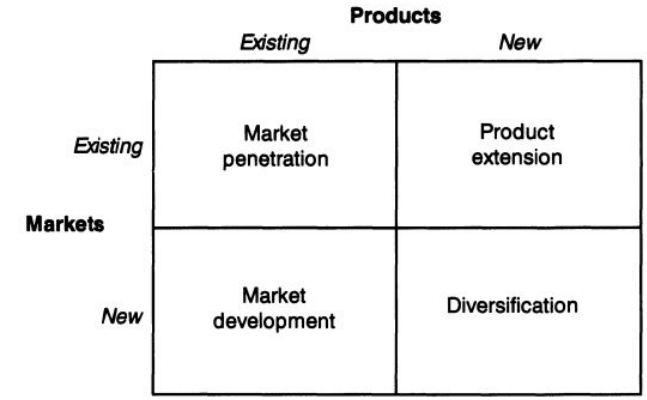
Anosff matrix has four strategies: market penetration, market development, product development and diversification. Firstly, market penetration is the way through which companies take various steps, such as: utilising creative promotional activities, and provide discounts to increase sales in the market they do business (Hussain et al., 2013). Secondly, Product development is the way of improving the quality of current products or inventing new products to increase sales (Baker, 2010). Thirdly, Market development is the way of entering a new market with the current products of an organization (Darroch, 2014). Fourthly, diversification is the strategy of entering in a new market with new products to improve the current products of an organization (Baker, 2010). The disadvantage of the model is it ignores the competitors of a market and focuses on product and market only; therefore, the model may not bring expected growth for companies.
JCPenny conducts some strategies of Ansoff’s growth matrix in order to get high revenue and ensure growth. JCPenny provides steep discounts on their products to attract more customers toward them and increase sales (Forbes, 2020). It refers to the strategy of market penetration because the company takes various marketing steps to increase sales in its existing market which is the US. JCPenny’s targeted customers were younger girls and used to produce clothes for their targeted customers but it has switched to women of 45 and up and produces clothes for them. It refers to the product development strategy from Ansoff matrix because the company started producing clothes for 45 aged women and women more than the age US though avoiding manufacturing clothes for younger customers. It refers that JCPenny started producing new clothes to enhance sales within the US and achieve great growth.
Porter’s five forces model of JCPenny:
Yunna & Yisheng (2014) have revealed in their research that porter’s five forces model indicates the model through which companies can analyse the competition of the market where they have a business. JCPenny becomes capable of finding out the competition in the US market through conducting this model. The disadvantage of the model is it cannot be applied in complex firms and non-profit firms because it is too general an analytical framework.
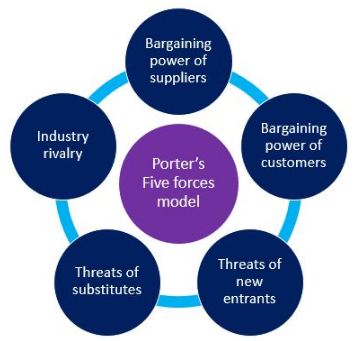
Threats of new entrants: Medium: The threat of new entrants is high for JCPenny because the company has lost its demand in the market and does not provide fashionable clothes as customers demand. New entrants can replace the company’s place by providing fashionable and good quality clothes because it will make customers satisfied and them purchase the products of the new brand. JCPenny has 846 stores across the US, which is a great coverage, and new entrants will not be capable of achieving the huge coverage because it takes a huge investment and time to achieve. In terms of presence, new entrants will not be able to replace JCPenny.
Threats of substitutes: High: Threats of substitutes is higher because there are many fashion brand in the US except JCPenny and all of the brands have huge collections. Switching costs for the substitutes are also lower than attracts customers toward the brands. Customers get more fashionable and better quality clothes than JCPenny which is one of the key reasons for the brand’s fall in the US market.
Bargaining power of suppliers: High: Suppliers have great power in front of JCPenny because the company sells cloth of different brands. The company have to pay a higher price for the products they purchase from suppliers because the company have business deals with limited suppliers.
Bargaining power of buyers: High: The bargaining power of customers is always higher for JCPenny. The world’s best fashion brands are situated in the US, and customers can choose any brand that they like. Customers prefer the most fashionable outfits and jewellery which are trendy, but JCPenny cannot fulfil this demand of customers. As a result, customers choose other fashion brands to meet their requirements and the sales of JCPenny fall by 4% (Forbes, 2020).
Competitive rivalry: Walmart, Costco, Target, and others are the top competitors of JCPenyy, and the competitors are providing lower costs with better quality products than the company, which is the key reason for the decreasing demand for the company’s products (Forbes, 2020). It refers to the tough competition that JCPenny faces, and competitors beat the company. For that reason, the company has had a net loss of $4.5 billion for the last ten years (Forbes, 2020).
Competitive rivalry: Walmart, Costco, Target, and others are the top competitors of JCPenyy, and the competitors are providing lower costs with better quality products than the company, which is the key reason for the decreasing demand for the company’s products (Forbes, 2020). It refers to the tough competition that JCPenny faces, and competitors beat the company. For that reason, the company has had a net loss of $4.5 billion for the last ten years.
Competitive rivalry: Walmart, Costco, Target, and others are the top competitors of JCPenyy, and the competitors are providing lower costs with better quality products than the company, which is the key reason for the decreasing demand for the company’s products (Forbes, 2020). It refers to the tough competition that JCPenny faces and competitors beat the company for that reason the company is having a net loss of $4.5 billion for the last ten years (Forbes, 2020).
PESTLE Analysis of JCPenny:
Srdjevic, Bajcetic & Srdjevic (2012) have stated in their research that PESTLE analysis is the tool which analyses the impact of the macro environment of an organization and how the company can face the impact. JCPenny will be capable to know about the effect of the macro environment on their business which will give them the direction to take effective steps to minimize the effects of the environment. The disadvantage of PESTLE analysis is it provides the outside perspective of a business without considering internal factors like competition.
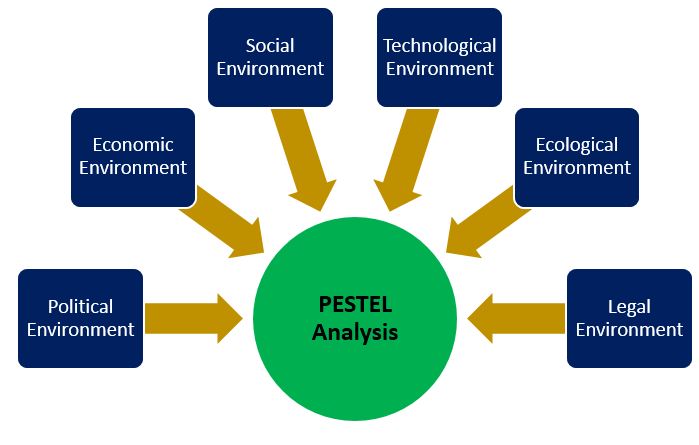
PESTLE Analysis (B2U, 2020)
Political environment: JCPenny is an American brand and has business in the local countries only for that reason political environment of the US influences the operations of the brand. The political environment of the US is stable (Britannica, 2020). The political stability of the country ensures that regimes are not changed radically; therefore laws and regulations do not change suddenly. As a result, JCPenny can focus on its operations effectively because the rules and regulations are fair, and the country does not change the rules suddenly.
Economic environment: US has one of the most powerful economies in the world with 21.428 trillion (World Bank, 2020). It refers to the economic stability of the country and financial stability of the US people which helped JCPenny to grow across the country because US people can afford their products easily. As a result, the brand established 846 outlets across the US which have become possible because of the economic stability of the company (Statista: 3, 2020).
Social environment: Social environment also impacts JCPenny’s operations. For instance, US male and female are more fashion conscious than in other countries but JCPenny does not produce trendy and fashionable clothes (JSTOR, 2020). Because of this reason number of customers of the brand has been decreasing day by day, and the company is losing its market share. Older women make fewer purchases than younger girls and the main target market of JCPenny is older women which is one of the key reasons for the decreased profit of the company.
Technological environment: US is the most technologically advanced country in the world and most of the companies of the country have utilized the advancement of technology to foster their growth but JCPenny failed to cope up with this factor. Competitors like Walmart do digital sales, and other companies also focus on increasing their sales by utilizing the scopes of digital sales (CNN Business: 1, 2020). JCPenny ignored the fact and did not focus on enhancing sales with digital media which also made the company fail because most the customers prefer online shopping in this advanced era.
Legal environment: JCPenny is an American company and the company have to maintain all the rules and regulations of the country to avoid government interference in its operations. The company maintain employee right law, customer service law and other laws that help them to execute business without facing any legal obstacle within the US. For instance, JCPenny offers prize packages for both seasonal and existing employees which are gift bundles and travel opportunities of at least $2,500 (Dayton Daily News, 2020).
Ecological environment: Companies have to take sustainable steps to ensure their flawless operations without legal difficulties and enhance their reputation among customers; therefore JCPenny has taken ecological steps to save the environment and enhance their reputation toward the people of the US. It has committed to energy conservation, recycling and advancements in responsible sourcing For instance, JCPenny has taken steps to reduce greenhouse gas emissions to 15% in per square foot by 2020 (Sourcing Journal, 2020). It has made many customers loyal to them by reducing their environmental impact.
Bowman’s Strategy Clock on JCPenny:
Echchakoui (2018) has revealed in his research that Bowman’s clock is a model that helps companies to explore the options about how should companies position themselves and enhance their competitive position. JCPenny becomes able to select effective strategies to position themselves in the US market through conducting the strategies of Bowman’s clock strategy.
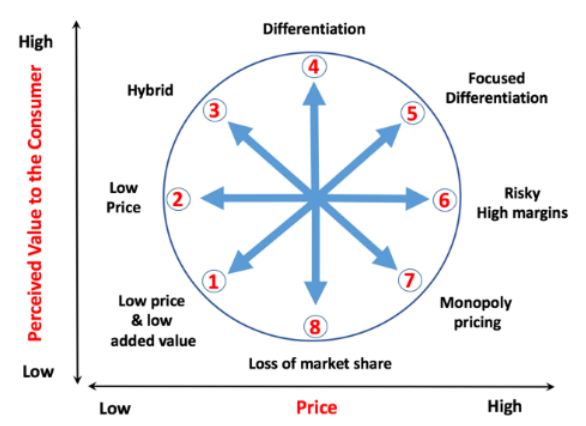
Bowman’s strategy clock (Tutor2u, 2020)
Bowman’s strategy has eight strategies. Firstly, low price and low-value strategy indicate where companies deliver products of lower value at lower prices (Shakhshir, 2014). Secondly, low price is the strategy that encourages companies to become lower-cost providers (Eyvrigh, 2016). Thirdly, hybrid refers to the strategy of offering low prices with little product differentiation (Desai, 2019). Fourthly, differentiation indicates providing products of the best quality at a premium price. Fifthly, focused differentiation ensures high perceived value with a premium price (Eyvrigh, 2016). Sixthly, risky high margins is a strategy where companies set higher prices without offering something extraordinary (Shakhshir, 2014). Seventhly, monopoly pricing is that strategy where customers have no choice and have to buy the products at their price (Echchakoui, 2018). Eighthly, the last strategy of losing of market share is that process where low perceived value is offered with the standard price that makes the company’s position a disaster in the market (Desai, 2019).
Among all the strategies, JCPenny has adopted the loss of market share strategy. The company does not deliver high perceived value because its clothes are unfashionable and out of trend, but they do not consider the price of its products. Whilst, competitors like Walmart, provide discounts on their world-class products, but JCPenny does not consider its price (CNN Business: 1, 2020).
The usefulness of JCPenny’s strategies:
Differentiation focus strategy from Porter’s generic strategies makes the business a zero-sum game: JCPenny uses differentiation focus strategy for strengthening their competitive advantage in the US fashion industry. The strategy is not suitable for JCPenny and it does not make a competitive position stronger. The company targets only women customers of age 45 who make fewer purchases than young girls in the country (CNN Business: 1, 2020). JCPenny tried to produce differentiated dresses to attract customers toward them but they are unable to make fashionable clothes and all of the produced items are out of trend. Even the company does not consider the price of their products which slows down its sales growth because customers are not ready to buy unfashionable clothes at a higher prices. Therefore, the revenue of JCPenny reduces. It seems that the differentiation focus strategy is also responsible for the bankruptcy of JCPenny.
Recommended strategy from Porter’s generic strategies: JCPenny should adopt a cost leadership approach which will assist them to reduce production and other costs and provide products at lower prices than competitors. This approach will help the company to bring many customers toward them because most of the customers avoid them for the irrelevant price of the products. The budget-conscious customers will buy JCPenny’s products after getting lower prices than others but the company have to maintain the quality and fashion of their clothes within the lower price. If they provide clothes of lower quality and outdated style, customers will not purchase JCPenny’s clothes. Therefore, the company have to produce clothes of good quality and fashionable by controlling costs and selling them at lower price. As a result, the competitive advantage of JCPenny will be stronger.
Market penetration couldn’t increase the profit level of JCPenny: JCPenny conducts different types of promotional steps to increase sales in the US. It offers steep discounts to customers to attract them toward its products. It helps JCPenny to bring many customers toward them but the company faced the loss of $101 million because of the provided huge discounts (Forbes, 2020). The company had a huge inventory and facing losses continuously; therefore the company offered steep sales accepting the loss to clear the inventory and get some money back that JCPenny has invested in the inventories. JCPenny did not conduct an effective promotional strategy, therefore, it failure to get targeted amount customers.
The recommendation in utilizing market penetration: JCPenny should conduct effective promotional strategies to attract more customers toward them. Competitors like Walmart are focusing on digital sales, which have fostered the sales of Walmart, and these types of steps keep them ahead of JCPenny because the company did not focus on digital sales yet (CNN Business: 1, 2020). The company should focus on digital sales, such as: taking orders through social media and websites, developing apps to make the selling process easier and other processes. It will make the company successful by attracting tech-savvy customers because 312.32 million people in the US use the internet, and JCPenny will be capable of capturing the huge customer base by ensuring home delivery (Statista: 1, 2020).
Product development strategy of JCPenny did not make them profitable: JCPenny’s clothes are out of fashion for that reason young customers started to avoid their clothes. The company did not produce any fashionable clothes because they have lack of employees and expert designers who can design good clothes. Therefore, JCPenny started focusing on women of 45 and up to that age through producing clothes for them because older women are not fashion conscious younger customers. The problem is that these types of women shop less, and it has made the target market of JCPenny shorter for that reason, the company is facing continuously.
Recommendations for product development strategy: JCPenny should target younger girls with older women and develop new designs for younger girls. Younger girls shop more than women when they get fashionable clothes from different companies. There are 10.57 million females living in the US between the age of 20 to 24 (Statista: 2, 2020). The amount refers to the great opportunity for JCPenny and the company should target the huge market with developed and fashionable dresses to capture the opportunity and generate a higher revenue than competitors.
The loss of market share strategy of Bowman’s clock strategy has made JCPenny fail: The loss of market share strategy has made JCPenny fail in the US fashion industry because the company does not deliver perceived value according to the price they set for their products. Even the clothes are out of date and have less quality which discourages customers from purchasing JCPenny’s products. As a result, the company filed for bankruptcy after struggling for many years.
Recommendations for Bowman’s clock strategy: JCPenny should adopt a low price strategy from Bowman’s strategic clock because it will assist the company in becoming a lower cost service provider within US fashion brands. Many people avoid the company’s products because of the irrelevant price, which will be covered up through the low-price strategy. People will make more purchases from JCPenny when they get the products will lower prices than other companies, but they have to maintain the quality also to increase sales.
Conclusion
JCPenny has done so many mistakes that have brought the company to this disastrous time. Firstly, the company sells unfashionable clothes with less quality, which fails to attract customers. Secondly, they do not focus on digital marketing, which is one of the key strategies of success in this advanced business world. Thirdly, JCPenny gives steep discounts and stops the discounts offered anytime, which has made customers annoyed on them and customers lose their trust in the company. Fourthly, the company did not conduct any creative marketing or promotional steps that could attract a huge range of customers toward them, and the company would not be bankrupt.
References
Britannica, 2020. Stable political systems. Retrieved from: https://www.britannica.com/topic/political-system/Stable-political-systems [Assessed on: 22 July 2020]
B2U, 2020. Scanning the Environment: PESTEL Analysis. Retrieved from: https://www.business-to-you.com/scanning-the-environment-pestel-analysis/ [Assessed on: 22 July 2020]
Dayton Daily News, 2020. JCPenney needs workers to meet holiday demand. Retrieved from: https://www.daytondailynews.com/business/jcpenney-needs-workers-meet-holiday-demand/wluyFyKwUWtIDps3HQqZ0M/ [Assessed on: 23 July 2020]
Forbes, 2020. Don’t Blame The Pandemic: JCPenney Goes Bankrupt After Decades-Long Struggle To Reinvent Itself. Retrieved from: https://www.forbes.com/sites/laurendebter/2020/05/14/jcpenney-bankruptcy-protection-coronavirus/#7cb4a2a21c8f [Assessed on: 24 July 2020]
JSTOR, 2020. The Fashion-Conscious American Male. Retrieved from: https://www.jstor.org/stable/40718569?seq=1. [Assessed on: 23 July 2020]
Sourcing Journal, 2020. J.C. Penney Steps Up Sustainable Sourcing Commitments. Retrieved from: https://sourcingjournal.com/topics/sustainability/j-c-penney-steps-up-corporate-sustainability-commitments-74809/ [Assessed on: 23 July 2020]
Tutor2u, 2020. Bowman’s Strategic Clock (Strategic Positioning). Retrieved from: https://www.tutor2u.net/business/reference/strategic-positioning-bowmans-strategy-clock [Assessed on: 23 July 2020]
World Bank, 2020. GDP (Current US)-United States. Retrieved from: https://data.worldbank.org/indicator/NY.GDP.MKTP.CD?locations=US [Assessed on: 22 July 2020]
